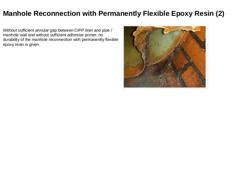
|
Without sufficient annular gap between CIPP liner and pipe / manhole wall and without sufficient adhesive primer, no durability of the manhole reconnection with permanently flexible epoxy resin is given. (Image: Manhole reconnection with permanently flexible epoxy resin - Resin separates from the host pipe surface) |
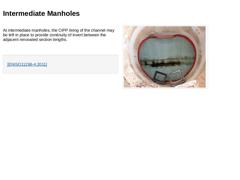
|
At intermediate manholes, the CIPP lining of the channel may be left in place to provide continuity of invert between the adjacent renovated section lengths. (Image: Intermediate manholes, the CIPP lining of the channel is left in place to provide continuity of invert between the adjacent renovated sewer sections) |
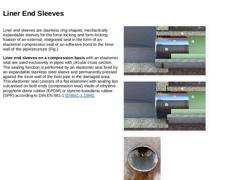
|
Liner end sleeves are stainless ring-shaped, mechanically expandable sleeves for the force-locking and form-locking fixation of an external, integrated seal in the form of an elastomer compression seal or an adhesive bond to the inner wall of the pipe/structure (Fig.). Liner end sleeves on a compression basis with an elastomer seal are used exclusively in pipes with circular cross section. The sealing function is performed by an elastomer seal fixed … |
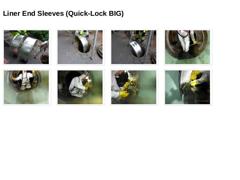
|
(Image: Separable sleeve – System Quick Lock Big) (Image: Insertion of the separable sleeve into the pipe system via the manhole) (Image: Assembly of the two sleeve parts at the liner end) (Image: Clamping the Quick-Lock BIG sleeve by expanding the spindle with the clamping tool [STEIN Ingenieure]) (Image: Clamping the Quick-Lock BIG sleeve by expanding the spindle with the clamping tool - Image 2) (Image: Clamping the Quick-Lock BIG sleeve by expanding … |
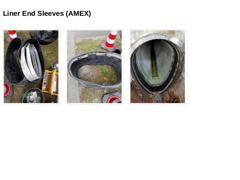
|
(Image: Components - EPDM sleeves consisting of ethylene-propylene-diene monomer (EPDM), stainless-steel tensioning straps, stainless steel tensioning wedges) (Image: Pre-assembled AMEX©-10 Liner End sleeve) (Image: Built-in AMEX©-10 Liner end sleeve with 2 tension starps) |
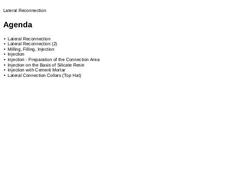
|
|
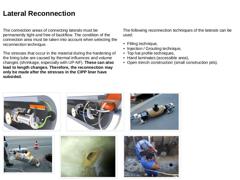
|
The connection areas of connecting laterals must be permanently tight and free of backflow. The condition of the connection area must be taken into account when selecting the reconnection technique. The stresses that occur in the material during the hardening of the lining tube are caused by thermal influences and volume changes (shrinkage, especially with UP-NF). These can also lead to length changes. Therefore, the reconnection may only be made … |
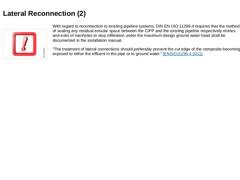
|
Important: With regard to reconnection to existing pipeline systems, DIN EN ISO 11296-4 requires that the method of sealing any residual annular space between the CIPP and the existing pipeline respectively entries and exits of manholes to stop infiltration under the maximum design ground water head shall be documented in the installation manual. "The treatment of lateral connections should preferably prevent the cut edge of the composite becoming … |
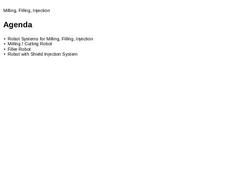
|
|
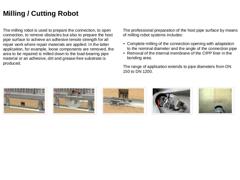
|
The milling robot is used to prepare the connection, to open connection, to remove obstacles but also to prepare the host pipe surface to achieve an adhesive tensile strength for all repair work where repair materials are applied. In the latter application, for example, loose components are removed, the area to be repaired is milled down to the load-bearing pipe material or an adhesive, dirt and grease-free substrate is produced. |
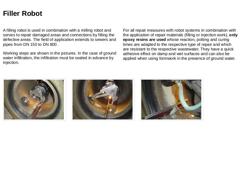
|
A filling robot is used in combination with a milling robot and serves to repair damaged areas and connections by filling the defective areas. The field of application extends to sewers and pipes from DN 150 to DN 800. Working steps are shown in the pictures. In the case of ground water infiltration, the infiltration must be sealed in advance by injection. For all repair measures with robot systems in combination with the application of repair materials (… |
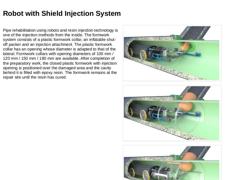
|
Pipe rehabilitation using robots and resin injection technology is one of the injection methods from the inside. The formwork system consists of a plastic formwork collar, an inflatable shut-off packer and an injection attachment. The plastic formwork collar has an opening whose diameter is adapted to that of the lateral. Formwork collars with opening diameters of 100 mm / 120 mm / 150 mm / 180 mm are available. After completion of the preparatory … |
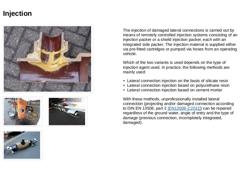
|
(Image: Section through a lateral connection area repaired by lateral connection injection) (Image: Lateral connection injection based on silicate resin - Janssen Process Lateral Repair technology) (Image: Lateral connection injection based on polyurethane resin - ProKasro injection system [FI-BEKATEC]) (Image: Lateral connection injection based on cement mortar - Hächler lateral inflow repair system. Injection unit, consisting of injection shield … |
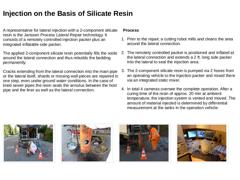
|
A representative for lateral injection with a 2-component silicate resin is the Janssen Process Lateral Repair technology. It consists of a remotely controlled injection packer plus an integrated inflatable side packer. The applied 2-component silicate resin potentially fills the voids around the lateral connection and thus rebuilds the bedding permanently. Cracks extending from the lateral connection into the main pipe or the lateral itself, shards … |
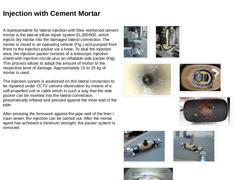
|
A representative for lateral injection with fibre reinforced cement mortar is the lateral inflow repair system EL300/600, which injects dry mortar into the damaged lateral connection. The mortar is mixed in an operating vehicle (Fig.) and pumped from there to the injection packer via a hose. To seal the injection area, the injection packer consists of a telescopic injection shield with injection nozzle plus an inflatable side packer (Fig). This process … |
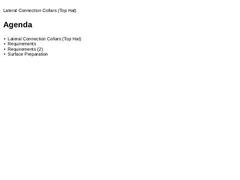
|
|
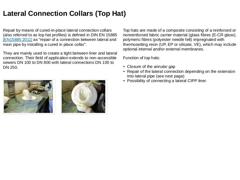
|
Repair by means of cured-in-place lateral connection collars (also referred to as top hat profiles) is defined in DIN EN 15885 [EN15885:2011] as “repair of a connection between lateral and main pipe by installing a cured in place collar”. They are mainly used to create a tight between liner and lateral connection. Their field of application extends to non-accessible sewers DN 100 to DN 800 with lateral connections DN 100 to DN 250. (Image: Impregnation … |
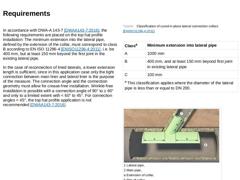
|
In accordance with DWA-A 143-7 [DWAA143-7:2016], the following requirements are placed on the top hat profile installation: The minimum extension into the lateral pipe, defined by the extension of the collar, must correspond to class B according to EN ISO 11296-4 [ENISO11296-4:2011], i.e. be 400 mm, but at least 150 mm beyond the first joint in the existing lateral pipe. In the case of reconnection of lined laterals, a lower extension length is sufficient, … |
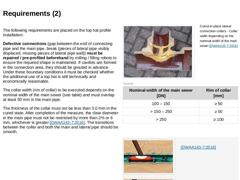
|
The following requirements are placed on the top hat profile installation: Defective connections (gap between the end of connecting pipe and the main pipe, break (pieces of lateral pipe visibly displaced, missing pieces of lateral pipe wall)) must be repaired / pre-profiled beforehand by milling / filling robots to ensure the required shape is maintained. If cavities are formed in the connection area, they should be grouted in advance. Under these … |
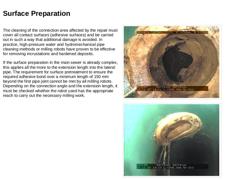
|
The cleaning of the connection area affected by the repair must cover all contact surfaces (adhesive surfaces) and be carried out in such a way that additional damage is avoided. In practice, high-pressure water and hydromechanical pipe cleaning methods or milling robots have proven to be effective for removing incrustations and hardened deposits. If the surface preparation in the main sewer is already complex, this applies all the more to the extension … |
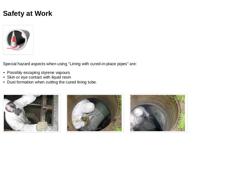
|
(Image: Picto Arbeitssicherheit) Special hazard aspects when using "Lining with cured-in-place pipes" are: -
Possibly escaping styrene vapours
-
Skin or eye contact with liquid resin
-
Dust formation when cutting the cured lining tube.
(Image: Full protection with breathing mask) (Image: Cutting the cured lining tube within arrival manhole - Image 1) (Image: Cutting the cured lining tube within arrival manhole - Image 2) |
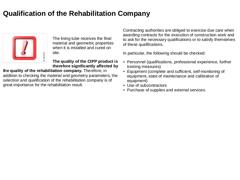
|
Important: The lining tube receives the final material and geometric properties when it is installed and cured on site. The quality of the CIPP product is therefore significantly affected by the quality of the rehabilitation company. Therefore, in addition to checking the material and geometry parameters, the selection and qualification of the rehabilitation company is of great importance for the rehabilitation result. Contracting authorities are obliged … |
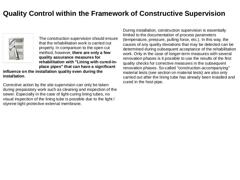
|
(Image: Picto Liste) The construction supervision should ensure that the rehabilitation work is carried out properly. In comparison to the open cut method, however, there are only a few quality assurance measures for rehabilitation with "Lining with cured-in-place pipes" that can have a significant influence on the installation quality even during the installation. Corrective action by the site supervision can only be taken during preparatory work … |
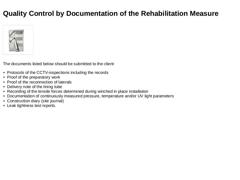
|
(Image: Picto Liste) The documents listed below should be submitted to the client: -
Protocols of the CCTV-inspections including the records
-
Proof of the preparatory work
-
Proof of the reconnection of laterals
-
Delivery note of the lining tube
-
Recording of the tensile forces determined during winched in place installation
-
Documentation of continuously measured pressure, temperature and/or UV light parameters
-
Construction diary (site journal)
-
Leak …
|
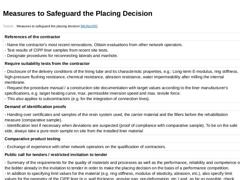
|
(Table: Measures to Safeguard the Placing Decision [MUNLV05]) |